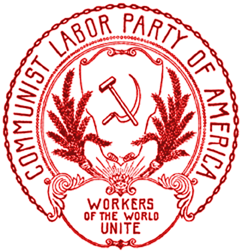GREEK ORGANIZATIONS
Early Greek Socialist Organization in America
Immigrants from Greece to America were part of the so-called “second wave" of immigration which took place at the end of the 19th Century. Due to poor economic conditions in the old country and active recruiting of (low cost) immigrant labor by labor brokers called padrones, several hundred thousand people had left Greece for America by 1920. The first radicals among this community saw themselves as an offshoot of the Greek Socialist movement rather than the anglophonic American. During the period 1910-1912, several branches of the League of Greek Workers and the Greek Socialist Party were established.
In 1912, a group of Greek workers in San Francisco established the Socialist Working Organization. The initial group consisted of 17 people, but this number is said to have soon doubled. The group shortly thereafter affiliated with the League of Greek Workers. In addition to the centers of San Francisco and New York, there seems to have been a significant Greek organization in the vicinity of Minneapolis-St. Paul.
Greek workers participated in a major strike at Grays Harbor, Washington in 1912. A public meeting of more than 300 was held.
There was a Greek socialist newspaper called The Voice of the Worker published in the United States during the 1920s, a publication which the Greek press of the Socialist Labor Party polemicized against repeatedly.
[fn. Kostis Karpozilos, M.A. thesis, 2004].
The Greek Federation of the Socialist Party of America
A Greek Federation of the Socialist Party of America was not established until 1917. In that year a “Greek Socialist Study Club”was formed, with activities being extended under the name “Greek Socialist Union."
Greek Organization in the Socialist Labor Party
The Socialist Labor Party of America did not have a formal Greek Federation, but it did publishe a Greek-language newspaper beginning in August 1917, Organosis [Organization]. The periodical was published at various intervals during its existence with an average press run in the general vicinity of 1,300 copies. The paper originate in Cincinnati before moving to Detroit and finally, from 1920, to New York, where it was published in the Divry print shop with an office maintained in Brooklyn.
The chief individual behind Organosis was Peter Tsistinas, a self-educated worker who had lived for an extended period in Serbia, entering the revolutionary movement there, before emigrating to the United States. Tsistinas was a member of the South Slavonic Federation of the SLP since that organization never had a sufficient number of Greek adherents to establish a formal Greek Federation.
The SLP did have active Greek branches in the early 1920s, however, including groups in Brooklyn, Chicago, Detroit, and Youngstown, Ohio. Other Greek activists lived in scattered other communities.
1. “Congress of the Greek Branches of the SLP”— Youngstown, OH — Dec. 1923.
A gathering of representatives of the Greek branches of the SLP was held in Youngstown, Ohio, during the last days of 1923. It was attended by six delegates representing five local branches (Brooklyn, Chicago, Detroit, Youngstown, and Zeigler, OH), with the delegates chosen on the basis of a for each 15 members of the organization.
[fn: Kostis Karpozilos, M.A. thesis, 2004]
A number of other pamphlets and leaflets were produced by the SLP in Greek during the decade of the 1920s, including DeLeon’s The Socialist Reconstruction of Society, Reform or Revolution?, What Means This Strike?, and Industrial Unionism, as well as material by others including The Communist Manifesto, Manifesto of the SLP, The Future Society, The Proletarian Through the Ages, and Eugene Sue’s The Silver Cross.
[fn:S. Kacogiannis: “Greek Organization”in 16th National Convention, Socialist Labor Party, May 10-13, 1924: Minutes, Reports, Resolutions, Platform, Etc., pp. 90-92.]
Greek Organization in the Communist Labor Party / UCP / unified CPA / WPA
R. Hasson of Chicago made the initial effort to organize a Greek Federation for the Communist Labor Party in the Fall of 1919.
Greek-American radicalism was centered in New York, where a group published a series of Communist-oriented newspapers which began with the monthly Phone tou Ergatou ["Voice of the Worker"] in 1918.
In December of 1920 none of the 673 primary party units of the United Communist Party spoke Greek.
2 — “Second Annual Convention”— (city?) — May 7-8, 1922.
Phone tou Ergatou ["Voice of the Worker"] went to weekly status in 1922, before changing its name to become Embros ["Forward"] in 1923. The paper continued to be issued with a series of other names until the early 1950s.
[fn: Dan Georgakas, “Greek Americans,”in Buhle, et al (eds.), Encyclopedia of the American Left (First Edition), pg. 278; Comintern Archive, f. 515, op, 1, d. 146, l. 131.]
Downloads
1923
undetermined date
Official 1923 data set of the Workers Party of America, compiled from a document in the Comintern Archive. This series shows a great numerical dominance of the WPA by its Finnish Federation, accounting for a massive 42.8% of the average monthly paid membership of the organization (6,583 of 15,395). The total of the English language branches is the 2nd strongest amongst the federations (7.6%) followed by the South Slavic (7.5%), Jewish [Yiddish language] (6.9%), and Lithuanian (6.0%) Federations. In all, there were statistics kept for 18 different language groups of the WPA in 1923, including the English and the barely organized Armenian sections.
“Initiation Stamps Sold by Federation for the Workers Party of America. January to December 1923.”
Official 1923 data set of the Workers Party of America, compiled from a document in the Comintern Archive. This series once again (repeating the previous published 1924 series) shows a schizophrenic pattern of stamp sales among language groups . Some federations clearly did not collect the initiation fees called for in the WPA constitution at all (Jewish, German, Latvian) while at the same time the quantities sold via the English branches are ridiculously high. Over 53% of the initiation stamps sold for the entire WPA were credited to the English branches — nearly three times as many initiations than there were average duespayers in those English branches! Even assuming a significantly higher than average “membership churn”rate for English branches, there is clearly some other unexplained phenomenon at play in these English branch initiation stamp sale figures...
undetermined date
Official 1924 data set of the Workers Party of America, compiled from a document in the Comintern Archive. This shows a continued numerical dominance of the Workers Party of America by its Finnish-language federation, averaging a paid membership of 7100 (41% of the entire organization) for the year 1924. Impressive growth is shown by the Yiddish-language ("Jewish") federation, which moved to the third largest language group in the WPA in 1924. The English branches comprised the second largest language group in the WPA, but still remained just 11% of the overall organization. The South Slavic federation (predominately Slovenian and Croation) was the 4th largest language group in the WPA, topping the Russian, Lithuanian, and Ukrainian federations.
“Initiation Stamps Sold by Federation for the Workers Party of America. January to December 1924.”
Official 1924 data set of the Workers Party of America, compiled from a document in the Comintern Archive. An extremely interesting monthly series in which two unexplained anomalies are apparent: (1) The failure of at least 8 of the WPA’s 18 language sections to make more than a token effort to collect the $1 initiation fee and obvious similar behavior (to lesser degree) among branches of other language groups; (2) A preposterously large sale of 5,264 initiation stamps to “English”branches, which averaged a paid membership of just 1909 over the course of the year. Either there was a revolving door in the English branches that was entirely dissimilar to the situation in any other language group of the WPA; or there was some sort of effort to collect initiation fees among “English”workers without organizational follow up; or there was some sort of strange accounting practice used by the WPA in which miscellaneous sales of initiation stamps were lumped into the “English”category (or some combination of these explanations). A perplexing question in raised, with further archival research clearly necessary.



